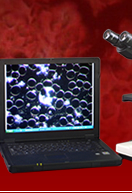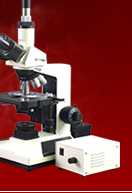
Simple Science Experiments for Students: Observing a Moss under a Microscope
Mosses are one of the easiest obtainable specimens that we can observe under a school microscope. We can find them on the ground and as well as fallen tree trunks, fences or places that are mostly left alone or undisturbed. Observing these green fuzzy plants can be an interesting as well as educational microscope activity for teachers and students.One of the most common mosses that teachers can let their students observe under a stereo microscope is the Hairy-caps. These can be found at the borders of wood-trails and cover the ground in almost all places.
If we look at a single hairy-cap moss plant under an low power educational microscope, we will able to take a closer look at its structure. It consists of a vertical stem with small thin leaves that are spirally-arranged. From the leaves, a long stalk grows with a spore at the end. A common moss is attached to the ground with stout root-like hairs called rhizoids.
The spore that is attached to the leaves by a long stalk is the fruit of the moss. It is also called a sporophyte. If we look at these spores under a low power stereo binocular microscope, we will see that the spore case looks like a thin capsule or cylindrical box that is carried by a flexible stalk. Sometimes, it is covered with a hairy cap in light-brownish color or veil. Once the veil falls off, you will be able to see the case to be tightly shut around by a lid.
If we observe a mature hairy-cap under a stereoscopic microscope, we will see that the stalk is bended almost horizontally. In this position, the lid is pushed by a ring of short cells that look like beads. Once the bead-like cells have fallen off, you will able to see a number of teeth-like projections that border the rim of the case. If we look closely at their extremities using more magnification, we will see a thin membranous disk that closes the case. These teeth are sensitive to the weather. On damp weather, they hold the membranous disk to prevent the spores from escaping. On the other hand, they form a ring of holes between the teeth during the dry weather so that the spores can pass through.
These spores are carried away by the wind and germinate where they land on. A germinating spore branches into a filamentous green structure called Protonema. This is the felt-like tangled green forms that we can see where mosses are growing. Let us obtain some of these protonema, place a little sample on a microscope slide with a drop of water and put a cover slip on top. Many microscope kits come with the needed accessories to create your own microscope slides.
Under a high power compound light microscope, we will see little knots or enlarged areas. These are the buds that will grow into the leafy stems of the moss. Little organs will eventually appear on these leafy stems that will produce the sporophyte.
One of these organs is the moss’ egg cell called the archegonium and the other is the antherifium that contains two-tailed sperm. Upon the union of the sperm cell and the egg cell, the egg cell divides exponentially until it results into a tissue called sporogonium. This is the moss plant’s fruit and is carried by the archegonium. As the fruit grows the archegonium tears away from the base and goes up on the stalk as the veil on the sporogonium. When the spores ripen, the process will go all over again.
Observing mosses under a low power dissecting and high power compound microscope will give us a better understanding on how these little plants help nature. With their spongy structure, they can absorb and retain water and therefore prevent excessive water rushing from the mountains to the valleys. Children and kids can learn and have an exciting educational time with this activity.




